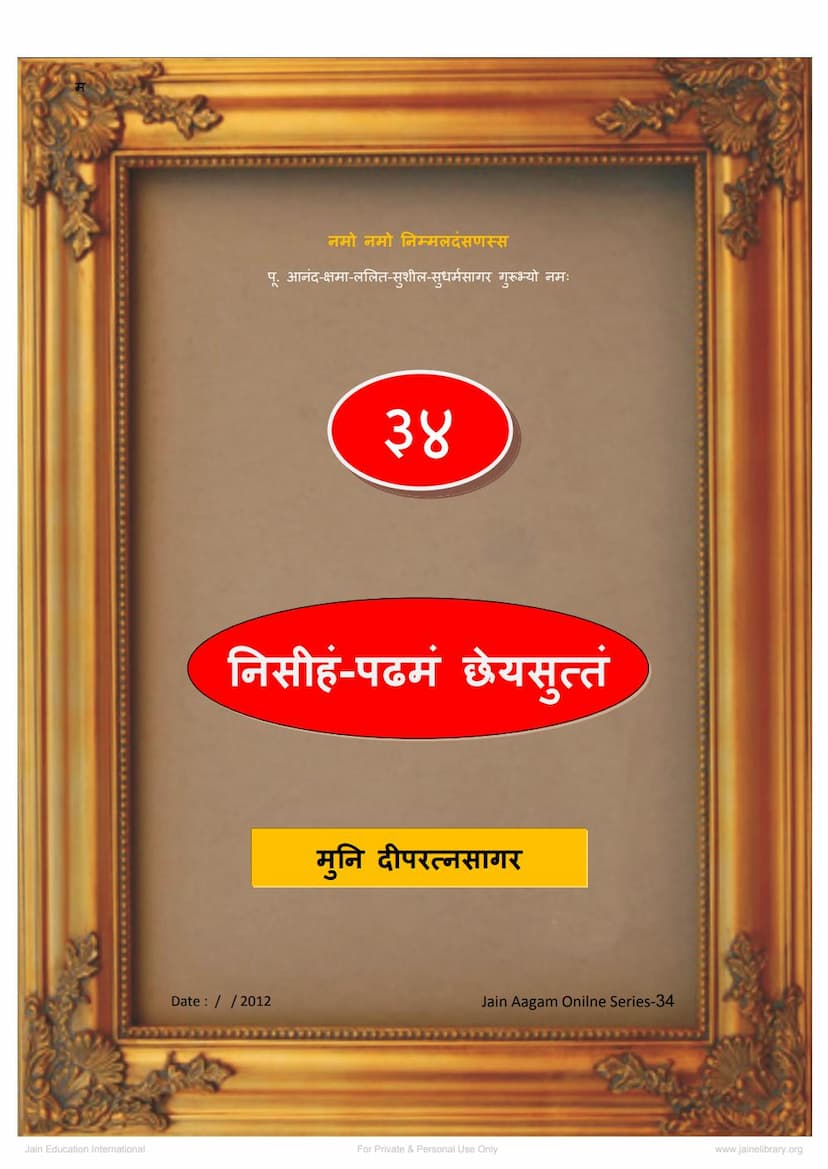Agam 34 Nisiham Padhamam Cheyasuttam Mulam PDF File
Added to library: September 1, 2025

Summary
This Jain text, Nisiham Padhamam Cheyasuttam, is part of the Agam literature, specifically Agam 34, and is the first Cheyasuttam (a type of scripture dealing with ethical conduct and penance). Edited by Muni Diperatnasagar, it was published by Deepratnasagar. The text outlines a comprehensive list of transgressions or offenses (saatijati - punishable) for Jain monks and nuns, categorized into various sections called Uddeso (sections or chapters).
The Ganthaanukkamo (Table of Contents) indicates the text is divided into fifteen sections, with a total of 1420 sutras (verses or aphorisms). The primary focus of these sutras is to detail specific actions or behaviors that are considered violations of Jain monastic discipline, leading to penance or punishment.
The text is structured by Uddeso, each detailing various prohibited actions. The content can be broadly categorized into the following themes:
Key themes and types of transgressions covered:
- Bodily actions and personal hygiene: Many sutras address actions related to the body, such as washing, anointing, cleaning nails, ears, and teeth, often specifying the use of permitted or forbidden substances and methods. For example, sutras detail offenses related to improper washing of feet or body, using oil, ghee, or powders in prohibited ways.
- Handling of objects and food: The text enumerates offenses related to the handling of various objects, including tools, vessels, clothing, and bedding. It also details improper consumption or handling of food and drink. This includes prohibitions on accepting or consuming food offered by specific individuals or in certain situations, and rules regarding the preparation and consumption of meals.
- Monastic duties and interactions: Numerous sutras focus on the conduct of monks and nuns in relation to their duties and interactions with the community, including interactions with householders, other ascetics (including those from different sects), and within the monastic order itself. This includes rules about entering houses for alms, taking offerings, and maintaining the sanctity of places of residence and worship.
- Specific prohibited activities: The text lists a wide range of specific activities considered offenses, such as:
- Making or using tools and implements improperly.
- Engaging in activities that could be considered attachment or indulgence, like beautifying oneself or one's belongings.
- Improper cleaning and maintenance of personal items and living spaces.
- Engaging in activities that are deemed unnecessary or contrary to ascetic principles.
- Interacting with or accepting things from individuals or groups that are outside the Jain fold or considered impure.
- Various forms of bodily care and modification, including trimming nails, hair, and dealing with bodily excretions.
- Certain types of conversations or interactions, especially those deemed impure, harsh, or associated with worldly pleasures.
- Activities related to specific places or circumstances, such as dwelling in certain locations, or engaging in activities during specific times.
- Transgressions related to the use and maintenance of essential items like bedding, bowls (
padigraha), and utensils.
- Intent and circumstance: The sutras often highlight the importance of intent (
anatthaya) and the circumstances under which an action is performed, which can determine the severity of the transgression and the prescribed penance. - Penances and punishments: The phrase "saatijati" (
सातिज्जति) appears repeatedly, indicating that the action described is punishable. While the specific penances are not detailed within this excerpt, the implication is that a system of penance (maasikam, chaaturmaasikam, paryahaaradaanetc.) is associated with these offenses.
Notable aspects:
- Repetitive structure: Many sutras follow a similar pattern: "If a monk/nun does X, they are guilty." This structure makes the text a comprehensive code of conduct.
- Detailed prohibitions: The text is highly detailed, covering a vast array of potential violations, from seemingly minor actions to more serious breaches of discipline.
- Focus on purity and non-violence: The underlying principle guiding these rules is the adherence to ahimsa (non-violence) and the maintenance of purity in thought, word, and deed, essential for spiritual progress in Jainism.
- Role of "Annyotthiyena va Garatthiyena va": Many offenses are related to actions performed with or influenced by outsiders (
annyotthiyena) or householders (garatthiyena), highlighting the strict boundaries monks and nuns must maintain with the lay community.
In essence, Nisiham Padhamam Cheyasuttam serves as a foundational text for understanding the rigorous code of conduct expected of Jain monks and nuns, providing a detailed framework for their daily lives and interactions to uphold their spiritual path.